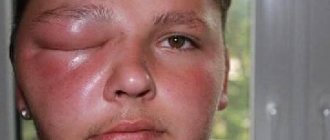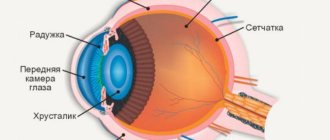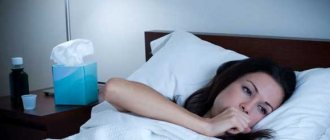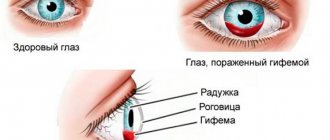The nature of eyelid swelling can be inflammatory or non-inflammatory. Inflammatory edema is associated with severe redness of the skin, local fever, and pain when pressed. Often, palpation of the edematous eyelid may reveal pain and induration (with barley, dacryocystitis, furunculosis, erysipelas). Non-inflammatory swelling of the eyelids is characteristic of diseases of the cardiovascular system or kidneys, and is always bilateral, more pronounced in the morning and almost always combined with swelling of the legs or ascites.
Symptom Definition
How and why do eyelids droop in the morning? Should I be afraid of this symptom? How to remove swelling from the upper eyelids, read here.
Edema of the upper eyelid is an accumulation of fluid in the intercellular space . The fact is that the skin around the eyes contains practically no fat cells that could absorb excess water.
The eyelids, both upper and lower, are prone to swelling. This is due to the anatomical structure of this area. The eyeball is surrounded by loose fatty tissue that is prone to fluid accumulation. When there is an excess of moisture, these tissues bulge and seem to swell. These tissues are held together by a thin connective membrane. The skin of the eyelids, not rich in elastic fibers, turns into a bag, and swelling of the eyelids becomes noticeable in the morning. The thin skin of the eyelids, stretching, can itch. It has an extensive vascular network, and this, under certain conditions, promotes the transfer of moisture from the bloodstream to the surrounding tissues.
Physiotherapy for swelling of the eyelids
Physiotherapeutic procedures can be called massage at the cellular level. They are quite effective, prescribed in courses and have almost no contraindications. This type of therapy promotes the drainage of excess fluid and improves blood circulation, and helps quickly eliminate swelling and redness. Physiotherapy is used for various ophthalmopathologies. For swelling of the eyelids, the following methods are used:
- electrical stimulation;
- myostimulation;
- fractional thermolysis;
- cryotherapy.
Mesotherapy—subcutaneous injections—is popular today. Various solutions can be used, but the most commonly used is hyaluronic acid. The therapy allows you to quickly eliminate swelling of the eyelids, smooth out wrinkles, and improve the tone of the facial skin and muscles. However, the effect of the injections is temporary. If the swelling of the eyes is caused by a pathology, then it is necessary to treat it, and not to stop a separate symptom.
Causes
Puffiness around the eyes can occur for almost any reason. If the upper eyelids are swollen, the reasons can be serious, requiring treatment, and in some cases they are quite banal and lie in the little things, by eliminating which the person will regain a healthy appearance.
With repeated swelling of the upper eyelid, it is necessary to identify the causes of the symptom so as not to miss the initial stage of the disease that provoked this manifestation.
Most often, swelling of the upper eyelid appears in the morning. The reasons for this phenomenon may be harmless, but sometimes swelling indicates the presence of a disease.
Common reasons:
- Consuming large amounts of salt, which is known to retain fluid in tissues.
- Excess liquid drunk the night before. At night, processes in the body slow down, including the processing of water by the kidneys.
- Smoking tobacco, drinking alcohol, using psychotropic substances;
- Crying, which increases the secretion of tear fluid and activates blood circulation in the eye area. Often, wiping away tears leads to irritation of the eyelid tissue, which can cause it to swell.
- Careless manipulations with hands, for example, when the eyes itch. In this case, microtrauma and swelling are also possible.
- Stressful situations and lack of sleep;
- Uncomfortable head position during sleep;
- Cosmetology procedures. The occurrence of edema of the upper eyelid is possible with injections of Botox or its analogues, after tattooing of the eyelids, mesotherapy;
- Individual predisposition to edema;
- Visual fatigue;
- Eye strain during minor work, while driving a car;
- Abuse of computer games (in a child);
- After an insect bite or injury;
- Hormonal fluctuations in different phases of the menstrual cycle;
- Chronic fatigue and lack of sleep;
- Allergic reaction to cosmetics.
An insect whose bite can cause an allergic reaction
If the upper eyelids swell, the reason may be hidden in the banal process of aging. Age-related changes in the body significantly increase the tendency to edema.
Signs of eyelid swelling
Swelling of the upper or lower eyelid may be accompanied by the following symptoms:
- redness or, on the contrary, pallor of the skin;
- skin tension and thinning are felt, which manifests itself in increased shine;
- transillumination of blood vessels;
- small rash;
- swelling, enlargement of the eyelids;
- narrowing of the palpebral fissure;
- painful sensations;
- thickening of the eyelid;
- itching, burning;
- secretion.
These are just some of the symptoms that are directly related to the eyelids. With blepharitis, the patient's eyelashes may turn gray and fall out. Allergic conjunctivitis is accompanied by severe itching. Keratitis leads to decreased visual acuity. Only during the examination can the true cause of eyelid swelling be revealed.
Possible diseases
Edema can be inflammatory or non-inflammatory in nature. With inflammatory reactions, as already mentioned, additional symptoms occur.
If the eyelid of one eye is swollen, this may be caused by diseases such as stye, meibomitis or chalazion. If the infection touches the conjunctiva, then inflammation of the conjunctiva develops. In this case, the tissues of the lower and upper eyelids of the eye may be affected simultaneously.
Swelling of inflammatory etiology also occurs with colds and various sinusitis. If unilateral itching occurs and the upper eyelid swells, the causes are often associated with local exposure to an allergen or irritant. This often manifests itself as allergies around the eyes.
Treatment of styes on the eye with medications is described in the article.
Pathological conditions that provoke swelling of the eyelid:
- Diseases of the heart and blood vessels;
- Pathologies of the kidneys and urinary tract;
- Inflammation in the paranasal sinuses;
- Allergy;
- Disorders in the cervical area.
In pathologies of the cardiovascular system, swelling is often localized in the lower part of the body; accordingly, the lower eyelid swells, intensifying in the evening. In severe cases, swelling can spread to the face and eyelids. They are accompanied by fluctuations in blood pressure, shortness of breath, and heart rhythm disturbances.
Morning swelling is often a sign of kidney and urinary system diseases. This affects the tissues of the face and upper limbs. Swelling on the eyelids is combined with urinary disturbances and increased blood pressure.
If your upper eyelids swell in the morning regularly over a long period of time, you should consult a doctor and undergo appropriate tests.
In children, swelling of the upper eyelids most often occurs due to a cold. However, morning swelling of the eyes in a child may be a sign of a dangerous condition, for example, increased intracranial pressure.
Swelling of the upper eyelid in infants can occur due to the eruption of baby teeth, as well as milk intolerance or protein metabolism disorders. Older children may suffer from edema when spending long periods of time in front of a computer screen, tablet, etc.
Improper daily routine, passive lifestyle, oxygen starvation due to lack of walking - all this can lead to swelling of the upper eyelid.
How to avoid relapse of the disease
Diseases of the visual organs, whether conjunctivitis, stye, blepharitis or allergies, are directly related to the state of the human immune system. When the immune system is weakened due to frequent colds, inflammation of various types, and infections, the body loses its natural defenses and becomes vulnerable to viruses, bacteria and parasites, which provoke inflammation and swelling of the eyelids.
What should you do to avoid relapse? If the upper eyelid of one or both eyes is constantly swollen, you should undergo a full ophthalmological examination and, if everything is normal, simply reconsider your lifestyle, paying attention to hardening, proper nutrition and sports. As soon as your body gets stronger, relapses of unpleasant diseases will stop.
Diagnostics
In most cases, the doctor can make a diagnosis after an external examination of the patient and collection of anamnesis based on the clinical picture. The doctor determines the presence or absence of elevated body temperature, the presence of erythema, the nature of the edema (bilateral or unilateral), as well as the degree of pain.
Additional research is needed if:
- Trauma;
- Subcutaneous cellulite;
- Cavernous sinus thrombosis;
- Systemic diseases.
When should you see a doctor?
Physiological swelling of the eyelids does not require specific treatment. It will go away on its own after eliminating the provoking factors. Sometimes just getting some sleep is enough. However, in some cases, this unpleasant symptom indicates the development of serious diseases that require the intervention of specialists.
Allergy
An allergic reaction, or sensitization, is a reaction to certain substances. The antigens to which the body reacts violently can be anything. Scientists still cannot name the exact reasons for the appearance of allergies on the eyelids, but they identify a number of provoking factors. These include:
- medications;
- Food;
- dust;
- animal hair;
- plant pollen;
- cosmetics.
A reaction on the organs of vision occurs when there is direct contact with an allergen. And in some cases, contact with the eyelid is enough. This reaction is due, first of all, to the fact that the eyes themselves are very sensitive. They are quickly influenced by irritants from the external environment.
INTERESTING! A characteristic feature of allergic edema is that it affects the upper eyelid. If the lower part is also involved in the process, this indicates a neglected state.
With increased sensitivity to decorative cosmetics, tingling, burning, itching, and redness appear. Rashes or bruises are sometimes observed.
It is mainly the upper eyelids that swell, which makes it difficult to close them. Sometimes the eyes become so swollen that they cannot be opened.
The eyelids may itch due to wearing contact lenses with incorrectly selected diopters. And itching also appears in response to the use of eye drops or low-quality decorative cosmetics.
If your eyelids are not only swollen, but also very itchy, this may indicate an allergic reaction.
My eyes also itch after working at the computer for a long time. However, this has nothing to do with allergic itching. We can talk about sensitization only when observing a set of clinical symptoms.
NOTE! An allergic reaction may be caused by the influence of subcutaneous mites, which can easily live in glasses frames.
Sensitization can cause weakness, pallor, and headache. Allergic edema itself is not difficult to detect even at home. On numerous Internet resources you can see photos of this condition.
The body's violent reaction may worsen, so when the first signs of an allergy appear, the patient must be given help. However, it is best to avoid amateur activities. If you are not sure about the effect of a particular drug, it is better not to give it to the patient.
In order to relieve allergic swelling, you must first identify the allergen and exclude the body from contact with it. To speed up the elimination of antigen and toxic substances, you should drink plenty of fluids. Sorbent preparations will help speed up this process. Antihistamines quickly and effectively relieve allergy symptoms.
Demodicosis
The disease is caused by a mite of the genus Demodex, which lives in the body of many people and behaves neutrally. Parasitic pathology is difficult to diagnose, which is why it often enters an advanced stage.
IMPORTANT! It is impossible to see a tick with the naked eye.
Dead skin cells that accumulate in the corners of the eyelids provide a breeding ground for these parasites. Decreased immunity can cause active reproduction of this opportunistic organism.
Demodicosis is accompanied by the appearance of the following symptoms:
- burning and itching;
- eyelash loss;
- peeling of the skin;
- redness of the mucous membrane;
- dry eyes;
- yellow mucous secretion.
With demodicosis, the skin peels off
Treatment of demodicosis is a rather lengthy process. Unfortunately, medications do not always work as they should.
REFERENCE! It is impossible to completely remove the parasite that causes demodicosis.
Therapeutic therapy is aimed not just at eliminating symptoms, but also at restoring the body's defenses. You can use medications only after visiting a dermatologist and ophthalmologist.
For more effective treatment, the skin of the eyelids should be cleansed before using topical products. For this purpose, it is recommended to use alcohol tincture of calendula.
Blepharitis
This is a disease characterized by inflammation of the edge of the eyelids. The disease is difficult to treat and often becomes chronic. Pathology exhausts a person and significantly reduces the quality of life.
Blepharitis can be infectious or non-infectious. The causative agents of the disease can be viruses, bacteria and fungi. Non-infectious causes include allergic reactions and ophthalmological disorders. As for infectious blepharitis, it most often affects the hair follicles of staphylococci. A predisposing factor in the development of pathology may be chronic lesions in the tonsils, oral cavity, and paranasal sinuses.
Pathology manifests itself in the form of the following symptoms:
- edema;
- redness;
- itching;
- blurred vision;
- discharge that sticks together the eyelids;
- rapid eye fatigue.
What to do if this disease is detected? The patient must prepare for long-term treatment. Therapy includes the use of both local and systemic drugs. Treatment methods vary depending on the cause of blepharitis.
For the infectious type, antibacterial therapy is indicated. Warm compresses and rinsing the eyelids with antiseptic solutions are used as auxiliary aid. If the cause of the inflammatory reaction is dry eye syndrome, artificial tears are prescribed. Sometimes ophthalmologists recommend the use of steroids in the form of drops or ointments for a short time.
In case of dysfunction of the sebaceous glands, the patient is prescribed a light massage. It will prevent the accumulation of sebum in the glands. In the case of allergic blepharitis, antihistamines cannot be avoided.
If the disease is not treated in time, it can cause serious complications such as:
- barley,
- chalazion,
- dry mucous membrane,
- lacrimation,
- retinal lesions.
As for preventive measures, to prevent blepharitis, chronic foci of infection should be treated promptly. If sensitization occurs, contact with allergens should be avoided.
Treatment
It is possible to relieve swelling only after identifying the cause that provoked this symptom. If the culprit is lack of sleep or disturbances in water-electrolyte metabolism, then in this case it would be appropriate to normalize sleep patterns, take diuretics and limit fluid and salt intake.
For swelling the following can help:
- Lymphatic drainage massage;
- Eye exercises;
- Applying ice;
- Masks;
- Cooling eye gel.
For swelling of the upper eyelids, eye exercises performed every 3 hours give good results. An example of one of the exercises: hands are placed on the temporal region and, with the help of facial movements, they try to return the skin back to its original position.
A mask made from parsley mixed with sour cream is very effective.
If the cause of swelling of the upper eyelid is an allergic reaction, then, in addition to eye medications, lymphatic drainage massage will have a good effect at the initial stage . It is performed by massaging the temples and corners of the eyes for 2 minutes. At the end of the massage, lightly tap with your fingertips around the eyes.
Read the link to see which allergy eye drops you should take.
For swelling of the upper eyelid, ice cubes are placed on the eyes and held for 5-10 minutes to stimulate blood circulation. Cubes prepared with sage decoction give an excellent effect. In addition, you can use an eye gel made from herbal ingredients. It is applied immediately after waking up or before applying makeup and kept for no more than 10 minutes.
Often women experience allergic swelling as a result of using low-quality or incorrectly selected decorative cosmetics. In this case, you should replace it with hypoallergenic cosmetics.
If swelling occurs regularly and the cause cannot be found, a full examination of the body is necessary, which will most likely reveal some diseases of the internal organs.
When swelling of the upper eyelid is caused by an inflammatory formation, for example, barley, then during its treatment it is necessary not to damage the lesion itself, otherwise the bacteria accumulated there will spread throughout the entire face. In this case, you need to take hygiene procedures seriously: wash your hands and face more often. The treatment regimen is simple - eye ointments and drops with antibacterial and anti-inflammatory effects are used, traditional medicine is used to relieve symptoms, and after recovery, a course of local and general vitamins is required. Tetracycline ointment for stye on the eye is most often used.
Find out about folk remedies for stye on the eye, as well as what eye drops you should use for stye on the eye, here.
There is a more serious cause of swelling - drooping of the upper eyelid. This disease is called ptosis of the upper eyelid (“ptosis” translated from Greek means “fall”). Ptosis can only be eliminated surgically.
Sudden swelling can be treated with home remedies. Contrast compresses, applying tampons made from herbal, potato, and tea decoctions help relieve unsightly swelling on the upper eyelid.
Normalizing your daily routine, healthy eating, giving up bad habits, long walks in the fresh air, dosed eye strain, and doing gymnastics are the first helpers in the fight against swelling of the eyelids.
Professional cosmetology also has an arsenal of methods that can get rid of swelling. Among such means it should be noted:
- Special creams;
- Lymphatic drainage methods;
- Myostimulation;
- Mesotherapy;
- Cryotherapy.
What to do if your eyelids swell?
This symptom can be relieved in various ways. However, it is necessary to identify the pathology that leads to its appearance. If your eyelids swell frequently or the swelling does not subside for a long time, consult an ophthalmologist. You may need to consult with other specialists. Although often the ophthalmologist is able to quickly identify the cause of swelling. It is enough for him to obtain information about the patient’s diseases, examine the eyelid, and check visual acuity. The doctor determines whether the patient’s temperature is elevated, whether there is erythema, or whether swelling develops in both eyes or in one. If a particular pathology is suspected, appropriate diagnostic methods are prescribed.
The following ways can help get rid of swelling:
- drug therapy;
- lymphatic drainage massage;
- physiotherapy;
- eye exercises;
- cosmetic masks and folk remedies;
- surgery.
The choice of treatment method is determined by the cause of eyelid swelling, its location and other factors. Medicines are selected based on the specific pathology. It would take a long time to list all the types of medications used for swelling of the eyelids. We will describe other ways to combat this symptom.
Preventive measures
Measures to prevent swelling of the upper eyelid:
- Timely treatment of inflammatory diseases;
- Limiting the consumption of table salt and liquid;
- Quitting tobacco and alcohol;
- Healthy lifestyle;
- Physical education classes;
- Hardening activities;
- Compliance with hygiene rules;
- Regular comprehensive medical examination;
- Observation by an allergist and compliance with his recommendations (for allergy sufferers);
- Compliance with safety regulations at work.
Reviews
Tatyana, 40 years old. I have dealt with bags under my eyes more than once. As soon as I drink alcohol or a little more water at night, the swelling is already visible in the morning. Cold helps me remove swelling, which is known to constrict blood vessels. I usually use chilled metal spoons. I put them in the freezer in advance and then apply them to my eyelids. For the procedure, six spoons are enough for me. I apply kitchen utensils to my eyes one by one. When one spoon gets hot, you can immediately replace it with another. Masks based on natural ingredients help me well. I really like the way aloe works. I squeeze the gel out of the leaves of the plant and spread it over the skin. And after a few minutes I wash it off with water.
Larisa, 43 years old. From time to time I experience swelling of the lower eyelids. I have chronic kidney disease, which is the cause of this unpleasant symptom. I mainly use folk remedies. A mask based on raw potatoes and parsley works well for me. I peel the vegetable and then grate it on a fine grater. I finely chop the greens with a knife and mix them with the potatoes. I apply the resulting mass to the lower eyelid area and cover it with a cotton pad. After fifteen minutes, I remove the product from my face and wipe my skin with cotton wool soaked in cooled green tea. Due to constant swelling, the dermis stretches greatly, so I use an elastoprotective eyelid cream. It contains a complex of amino acids, jojoba and corn oil, as well as collagen and elastin. The product effectively fights crow's feet.
Evgenia, 34 years old. I went to the doctor with complaints of severe swelling of the eyelids, peeling and itching. After examination, the ophthalmologist diagnosed demodicosis. This is a parasitic disease caused by the subcutaneous mite. The doctor immediately warned that the treatment would not be quick. I was prescribed special ointments that I used daily. As I understood from the words of the ophthalmologist, almost every person has a tick, but with a weakened immune system, the parasites can begin to actively multiply. Therefore, I was prescribed multivitamins to strengthen my immune system. I replaced the feather pillow with a hypoallergenic one, since mites actively develop in down. Demodicosis is a contagious disease, so I did not give my cosmetics to anyone. During the treatment I did not wear makeup at all. After the tests were normal, I bought new decorative cosmetics.
conclusions
So, the cause of swollen eyelids may be a symptom of ordinary fatigue, poor lifestyle, or a signal of the presence of a systemic disease. If this phenomenon occurs regularly, you should seek help from a doctor. Remember that prevention is the best cure. Any inflammatory process goes faster if normal metabolism is maintained in the body, and the person takes care of his health and leads a positively active lifestyle.
Also read in the material what to do if swelling of the upper eyelid appears.
How does eye gymnastics help eliminate swelling of the eyelids?
Exercising to relax the eye muscles also helps relieve swelling, redness and other signs from the eyelids. But this method of treatment should be considered as additional, not primary. In addition, it can prevent the occurrence of puffiness, bags and bruises under the eyes. To relax the eyelid muscles, you can do the following exercises:
- close your eyes tightly, count to 5 and open your eyelids wide, repeat these steps several times;
- close your eyes and open them, pressing slightly on the inner corners with your fingers;
- pull the lower eyelid towards the upper eyelid and hold it in this position for 5 seconds;
- Slowly rotate your eyeballs clockwise and counterclockwise.
After gymnastics, you can massage your eyelids.
The most important
Swelling of the eyelids is a common symptom that may be normal. Swelling often appears after drinking a large amount of water at once, or after visual strain. The cause may be an addiction to alcohol and salty foods. Swelling also signals the presence of pathologies in the body. Fluid accumulation occurs with kidney disease, cardiovascular disorders, allergic reactions, and parasitic diseases. It is not the swelling itself that should be treated, as it is only a symptom. First of all, it is necessary to find out the reason for this phenomenon. After eliminating the provoking factor, the swelling will go away on its own.
Swollen and painful eyelid in children: what to do?
Many parents ask what causes such a reaction. Most often this occurs as a result of a blow when a child is playing and accidentally injures himself. The lower or upper eyelid may become red and swollen as a result of an infection that the child receives after playing in the sandbox or during contact with animals.
An insect bite will cause the eyelid to swell. Inflammation can begin as a result of acute respiratory infections and other diseases. You can try blowing out the eye to remove foreign matter or dust.
If you have ruled out the above reasons, your child may have an allergic reaction. In any case, specialist help and treatment are needed. Don't hesitate if you notice your baby's right or left eye is swollen. Contact your doctor right away and do not try to treat your child yourself.
Return to contents
Prevention
To prevent the appearance of eyelid edema, you need to follow preventive measures:
- Proper nutrition (limiting salt, excluding alcohol).
- Get adequate sleep (at least 7 hours on a comfortable pillow).
- Using quality cosmetics.
- Avoiding contact with allergens.
- Eye protection from damaging factors (sunglasses, protective mask in hazardous industries, when welding).
- Compliance with the rules for using lenses (lenses must be selected correctly, the duration of wear must be observed, and they must be cared for).
- Contact a doctor early if pathological symptoms appear.
- Annual preventative medical examinations.
Swelling of the eyelids may not pose a health risk, but may indicate serious illness. Therefore, it is recommended to undergo an examination to find out the reasons.
Have you encountered such a symptom? Tell us about it in the comments. Share the article on social networks. Take care of your health. All the best.
The upper eyelid is swollen in one eye - what could be the reason?
All causes of this symptom can be divided into two groups:
- pathological: eye diseases and diseases of internal organs;
- non-pathological, which do not require treatment.
In this case, the first group of causes includes inflammatory and non-inflammatory edema. Most often they are associated with eye diseases, in which the tissues of the eyes and eyelids become inflamed. Among these pathologies:
- conjunctivitis;
- blepharitis;
- barley;
- chalazion;
- dacryocystitis.
In almost all inflammatory eye diseases, the eyelids become swollen or red. But the diseases listed have many similar symptoms. How to distinguish one from the other? Let us describe the symptoms of each of them separately.











